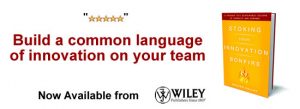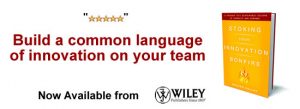Different Thinking is Needed
We Should Develop Our Skills at Divergent and Convergent Thinking
by Paul Sloane
 We are creatures of habit. Each day we wake up on same side of the bed. We put on the same type of clothes we wore the previous day, we eat the same type of breakfast, we sit in the same car and we take the same route to work or school. When we get there we think in the same way as we thought the previous day. Most of our thinking is in the same groove – it is analytical, convergent, critical, left-brain thinking. This is our normal mode of operation and it is hard to appreciate just how severely we hamper ourselves by restricting our thinking in this way. There are many other ways of thinking and of expressing our thoughts.
We are creatures of habit. Each day we wake up on same side of the bed. We put on the same type of clothes we wore the previous day, we eat the same type of breakfast, we sit in the same car and we take the same route to work or school. When we get there we think in the same way as we thought the previous day. Most of our thinking is in the same groove – it is analytical, convergent, critical, left-brain thinking. This is our normal mode of operation and it is hard to appreciate just how severely we hamper ourselves by restricting our thinking in this way. There are many other ways of thinking and of expressing our thoughts.
We express our thinking in words. It seems so natural to say things, to use words, to write routine memos, emails and reports that we rarely stop to ask if there is a better way to do things. But a mathematician expresses himself with equations, an accountant with numbers, an artist with pictures, a composer with music, an architect with drawings, an engineer with models, a movie director with moving images, a public speaker with oratory and stories. Why do we so rarely borrow any of their forms of expression?
In How to be a Brilliant Thinker we explore different kinds of thinking and other approaches to some of the mental challenges we face. Let’s start with convergent and divergent thinking. Convergent thinking is our normal state. When we hear a suggestion our instincts are to examine it, criticize it and analyze its consequences with particular emphasis on what might be wrong with it. We are trained at school and university to summarize, scrutinize and evaluate the works of authors, historians, and scientists. It is easy and natural for us to focus in on a notion and examine it critically from various viewpoints. We bring our own assumptions and mind-set to bear and put the new idea into the framework of the world as we see it.
Divergent thinking, on the other hand, involves moving away from the core subject in a spread of directions. When we use divergent thinking we can generate all sorts of ideas that are not obviously connected with the original challenge or concept. We stretch the boundaries and let our imagination generate many different possibilities – including wild or unsound ideas. It is the counterpoint to convergent thinking where we focus sharply on one target and narrow down our options to arrive at a chosen solution.
Furthermore we have a very disturbing tendency to only see and gather evidence that supports only our existing beliefs and to reject or ignore evidence that conflicts with our beliefs. We have a set of beliefs and assumptions and we look for evidence that bolsters this mind-set. If we believe that all squirrels are gray then every time we see a gray squirrel it reinforces our conviction. But seeing another gray squirrel is a very poor test of the rule. What we should do is look to see if we can find a single squirrel that is not gray. That would disprove the rule and move our knowledge forward. The first reports that black swans had been seen in Australia were disbelieved in Europe – the evidence did not conform to the conventional view of the world so it was discounted.
Brilliant thinkers recognize that there are many different views of the world and that each is incomplete. Our current mind set frames how we view the world but we must be ready to admit that it is just one of many views; it may be a good system but it is partial and needs to be refreshed with new information. Sir Isaac Newton redefined our understanding of the world with his laws of gravity and motion. It was an excellent model and served Science well for centuries until Albert Einstein updated it with his general theory of relativity. His view of the universe is constantly being examined and revised as new theories develop.
Einstein said, ‘Imagination is more important than knowledge.’ Divergent thinking allows us to use our imagination to explore all sorts of new possibilities. Convergent thinking allows us to use our knowledge to examine concepts and see where they fit. Unfortunately our natural tendency is to reject ideas if they are not aligned with our existing knowledge and belief systems. Divergent thinking involves considering all sorts of points of view – including the unconventional, the unfashionable, the ridiculous and the outlandish. It is an essential skill which goes unpracticed for many. There are times when we need the precision of convergent thinking and there are times when it is overly restrictive. The two main phases of a brainstorm meeting are good examples of how both methods can be employed in harmony. After the challenge has been defined, the group adopts a divergent thinking mode and generates a plethora of ideas. These will include many silly and unworkable notions but these are useful as stimulants to provoke further ideas. When a good list has been assembled the facilitator of the brainstorm will encourage the group to start using convergent thinking in order to evaluate the ideas and to select the best. It is vital that the two modes of thinking are used separately in each phase. If we mix convergent thinking with divergent thinking at the beginning then ideas are evaluated and criticized as soon as they emerge and the creative fountain will probably be extinguished.
The conventional thinker is normally stuck in convergent thinking mode but the brilliant thinker can use both these modes. There are times when we need to be analytical, calculating, critical and judgmental but if we use this approach too often then we become limited, constrained and even destructive in our thinking. We need to consider many possibilities, approach problems from different points of view, come at the problem laterally (literally from the side) if we are to be brilliant thinkers.

Don’t miss an article (1,950+) – Subscribe to our RSS feed and join our Continuous Innovation group!
 Paul Sloane writes, speaks and leads workshops on creativity, innovation and leadership. He is the author of The Innovative Leader published by Kogan-Page.
Paul Sloane writes, speaks and leads workshops on creativity, innovation and leadership. He is the author of The Innovative Leader published by Kogan-Page.
NEVER MISS ANOTHER NEWSLETTER!
LATEST BLOGS
The Second Coming of the Retail Health Clinic
There used to be a day when you could go to your local barber and get all sorts of wonderful…
Read MoreCan Microsoft out-innovate Google?
Microsoft announced today a round of updates to its Live Search offering. Searchengineland had a good story on the developments.…
Read More



Great article – thank you!
Divergent thinking should be a requirement in the creative industry – and indeed is where some great work has come from in the past. Pushing the metaphor etc.
Divergent thinking is also a great way to recreate the future – something I’m specifically interested in at the moment…
All the best
Neil
It is interesting that you link the most important kinds of thinking to problems. We face a problem, therefore we think. Might it not be that a yet more important form of thinking is one that occurs in the absence of any such problem?
There is a kind of thinking that is also a form of openness to the world around us (and there is a lovely contrast to this in Virginia Woolf’s “To The Lighthouse” where she describes Mr Ramsey, a philosopher, walking around the garden thinking about a philosophical problem and not being able to notice the flowers). This is a form of thinking that is also a way of feeling, whereas the kinds of thinking you describe seem to perpetuate the nasty fragmentation of thought and feeling – reason and unreason. I may be misreading you, though.